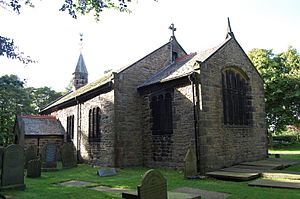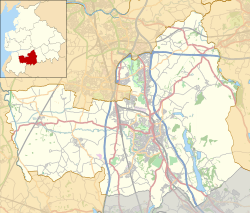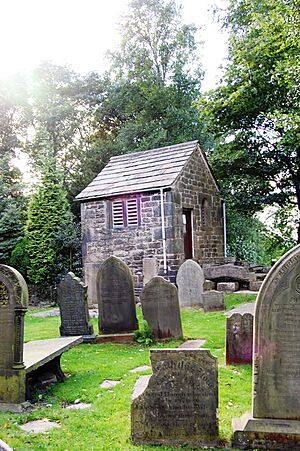Rivington Church facts for kids
Quick facts for kids Rivington Church |
|
|---|---|

Rivington Church
|
|
| 53°37′31″N 2°34′06″W / 53.6252°N 2.5684°W | |
| Location | Rivington, Lancashire, England |
| Country | England |
| Denomination | Anglican |
| Website | Rivington Parish Church |
| History | |
| Founded | 1566 |
| Architecture | |
| Functional status | Active |
| Heritage designation | Grade II Listed building |
| Specifications | |
| Materials | Sandstone |
| Administration | |
| Parish | Rivington |
| Deanery | Deane |
| Archdeaconry | Bolton |
| Diocese | Diocese of Manchester |
Rivington Church is an active Anglican parish church located in Rivington, Lancashire, England. It is part of the Diocese of Manchester. The church is a special historical building, officially known as a Grade II Listed building. It is simply called Rivington Church, as it is not named after a specific saint.
Contents
History of Rivington Church
Early Days and Foundations
Records from 1280 mention church land in Rivington. A very old Saxon font, used for baptisms, was found nearby. This font is now kept in the church's Millennium Room. The church also has a circular graveyard, which is a common shape for churches built a very long time ago. These clues suggest that a church might have been on this site even before the Norman Conquest in 1066.
In 1536, the priest was given 30 acres of land. In 1541, the chapel and its churchyard were officially dedicated. This means they were set aside for religious use. People living in the village said they had worshipped at this spot for many generations.
Royal Approval and Changes
In 1566, Queen Elizabeth I gave permission for a free grammar school and allowed the church to have its own minister. This meant that people from Rivington and nearby areas could have baptisms, marriages, and burials right there. Before this, they had to travel to other parishes.
In 1662, a minister named Reverend Samuel Newton was removed from the church. Many people who followed his Puritan beliefs also left. This event led to the creation of the Rivington Unitarian Chapel later on.
Building and Renovations
The church building you see today is mostly from 1666. It has been changed and repaired several times since then. A big restoration happened in 1861, costing £500. During this work, a new porch was added, special tiles were laid, and the altar area was improved. The old wooden screen was restored, and new seating was put in.
Rivington became its own parish, separate from Bolton le Moors, in 1856. This was special because the local people could choose their own minister. In 2014, a new extension was added to the west side of the church. This new part includes a reception area, a toilet, and a kitchen.
Church Structure and Design
Outside the Church
The church is built from sandstone blocks, with large corner stones called quoins. It has a slate roof. It's a simple, small building with three windows on each side. The main part of the church, called the nave, is about 55 feet long and 27 feet wide. The chancel, which is the area near the altar, is about 13 feet by 15 feet.
The main entrance is on the south side, with a gabled porch. The west wall has a doorway and an octagonal (eight-sided) bell turret. This turret has a pointed roof and a weather vane on top. The roof has green slates and overhanging edges.
The churchyard has very old gravestones, with the earliest one dating back to 1616. Some gravestones that are now flat on the ground were once raised up. During World War II, iron railings around some graves were removed to help with the war effort. The churchyard also contains three graves of British Army soldiers who died in World War I and World War II.
Near the entrance, there are special stones. One is the 'Anderton Stone,' which shows symbols from the Anderton family's coat of arms. Another stone has a carved Sator Square, which is a famous word puzzle.
Inside the Church
The church roof has strong wooden beams and supports. Inside, you'll find a beautiful old oak screen from the late Middle Ages. There's also an octagonal oak pulpit from the late 1500s. Both the screen and the pulpit are thought to be older than the church building itself!
On the north wall, there is a painting from 1835. It's a copy of an older painting from the 1500s that shows the family tree of the Pilkington family. There's also an 18th-century brass chandelier with two levels of arms for candles. The oldest memorial inside the church is from 1627.
The church has a pipe organ built in 1884 by Lewis & Co. It was repaired in 1927.
War Memorial
The war memorial inside the church remembers the men who died in the Great War (1914-1919) and World War II (1939-1945).
- John Wm Bain
- Ed. Berry
- Ed Berry
- Nathan Birchall
- T Birchall
- John Edward Berchall
- Ryder Doman
- Jas Edwards
- Wm Evans
- George Edwards
- Roland Foster
- Wm Farnworth
- Herbert Hitchen
- John King
- Asa Leadbetter
- John Parry
- Eric Pierce
- Eustace Blackburn Ritson
- Thos Ratcliffe
- Francis (Frank) Smith
- Jas Schofield
- Benjamin Webster
1939-1945
- William Almond
- Albert Gaunt
- Wm Gordon Ratcliffe
- William Spinks
The Belltower
The belltower is a separate building in the churchyard, also a Grade II Listed building. It's a small, square stone building with a basement and outside steps. It was built to hold a large bell bought from All Saints' Church, Wigan in 1542. However, this bell was sold around 1551. This detached bellhouse is the only one of its kind in Lancashire. It was once used to store bones, but now it's used by the church's caretaker for tools.



